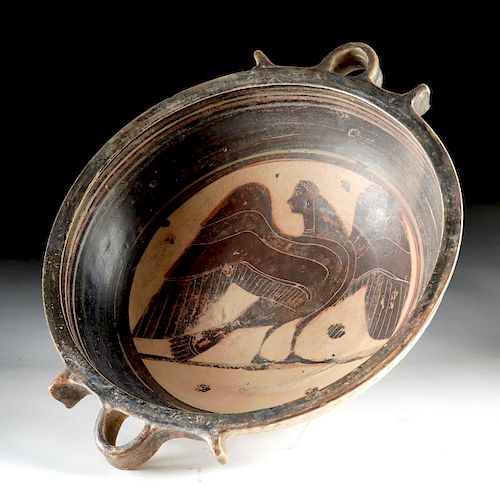Huge Greek Corinthian Phiale w/ Siren
Lot 23a
About Seller
Artemis Fine Arts
686 S Taylor Ave, Ste 106
Louisville, CO 80027
United States
Selling antiquities, ancient and ethnographic art online since 1993, Artemis Gallery specializes in Classical Antiquities (Egyptian, Greek, Roman, Near Eastern), Asian, Pre-Columbian, African / Tribal / Oceanographic art. Our extensive inventory includes pottery, stone, metal, wood, glass and textil...Read more
Estimate:
$8,000 - $12,000
Absentee vs Live bid
Two ways to bid:
- Leave a max absentee bid and the platform will bid on your behalf up to your maximum bid during the live auction.
- Bid live during the auction and your bids will be submitted real-time to the auctioneer.
Bid Increments
| Price | Bid Increment |
|---|---|
| $0 | $25 |
| $300 | $50 |
| $1,000 | $100 |
| $2,000 | $250 |
| $5,000 | $500 |
| $10,000 | $1,000 |
| $20,000 | $2,500 |
| $50,000 | $5,000 |
| $100,000 | $10,000 |
| $200,000 | $20,000 |
About Auction
By Artemis Fine Arts
Feb 21, 2019
Set Reminder
2019-02-21 10:00:00
2019-02-21 10:00:00
America/New_York
Bidsquare
Bidsquare : Exceptional Antiquities, Asian, Ethnographic
https://www.bidsquare.com/auctions/artemis-gallery/exceptional-antiquities-asian-ethnographic-3858
An important one-day auction featuring museum-worthy examples of Egyptian, Greek, Roman, Etruscan, Near Eastern, Far East / Asian, Pre-Columbian, African / Tribal, Oceanic, Native American, Spanish Colonial, Russian, Fossils, Ancient Jewelry, Fine Art, so much more! Artemis Fine Arts info@artemisfinearts.com
An important one-day auction featuring museum-worthy examples of Egyptian, Greek, Roman, Etruscan, Near Eastern, Far East / Asian, Pre-Columbian, African / Tribal, Oceanic, Native American, Spanish Colonial, Russian, Fossils, Ancient Jewelry, Fine Art, so much more! Artemis Fine Arts info@artemisfinearts.com
- Lot Description
Greece, Corinth, ca. 6th century BCE. A massive handled phiale or libation bowl, standing on a wide, round, disc foot. A magnificent black figure siren is painted in tondo, her body dominated by her massive avian wings, her human head turned back to look over her shoulder, a mane of thick, crimped hair falling down her back to her chest. Thick black and red bands of pigment continue up the rounded sides of the vessel, which has a thick, flat rim and two looped horizontal handles, each with projecting finials on either side of it. The exterior is similarly decorated with a wide register around its lower body depicting lions, deer, and swans encircled by small floral motifs. Size: 14.25" W x 3.45" H (36.2 cm x 8.8 cm)
The black figure technique originated in the Greek city of Corinth, and spread throughout Greece and the Classical world during the 6th century BCE, probably brought by immigrants from Greece. Incised lines create extensive detail on each of the figures. Our first knowledge of sirens comes from the Odyssey, when they are said to lure sailors by singing in "honey-sweet voices" and promising men great knowledge; the island they live upon is said to be littered with the bones of men lured to their death in this manner. The sirens are not described physically in the Odyssey, so the Greeks seem to have based their image of sirens on fantastical Near Eastern winged creatures, which were in turn inspired by the ba-bird of Egyptian mythology. The female siren figure is uniquely Greek, however - possibly inspired by the Odyssey. Sirens were bound up with ideas about death, mourning, and the underworld, although their role had changed from the murderesses of the Odyssey to mourners by the fifth century BCE, possibly because of a new fear of life after death that seems to have entered the Greek consciousness in the 6th century.
Provenance: private East Coast, USA collection; ex-William Froelich collection, New York, USA, acquired in the 1970s
All items legal to buy/sell under U.S. Statute covering cultural patrimony Code 2600, CHAPTER 14, and are guaranteed to be as described or your money back.
A Certificate of Authenticity will accompany all winning bids.
We ship worldwide and handle all shipping in-house for your convenience.
#141470Repaired and restored from multiple pieces. Little to no overpainting of motifs - just one small area on the interior foot has non-original pigment. Motifs are in great condition with some light wear commensurate with age but clear form and detail remaining.Condition
- Shipping Info
-
All shipping is handled in-house for your convenience. Your invoice from Artemis Gallery will include shipping calculation instructions. If in doubt, please inquire BEFORE bidding for estimated shipping costs for individual items.
-
- Buyer's Premium



 EUR
EUR CAD
CAD AUD
AUD GBP
GBP MXN
MXN HKD
HKD CNY
CNY MYR
MYR SEK
SEK SGD
SGD CHF
CHF THB
THB
















